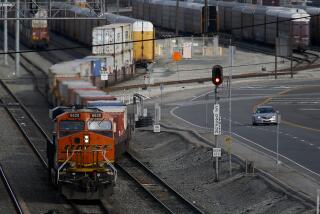Lapses Linked to Derailments Criticized : Congress: Lawmakers say federal agencies could have taken steps that might have limited effects of recent toxic spills.
WASHINGTON — House investigators castigated federal agencies Wednesday for failing to take steps that might have reduced damage from two train derailments that have caused toxic spills in the Sacramento River and the Ventura area.
Rep. Barbara Boxer (D-Greenbrae) called it an outrage that the government does not consider the substance that killed 200,000 fish in the Sacramento River a hazardous chemical, although the Coast Guard classifies it as a dangerous marine pollutant.
Boxer, presiding at a hearing of a House Government Operations subcommittee that is investigating the derailments, also prodded the Department of Transportation to move faster to mandate safer tank cars for transporting hazardous materials.
Rep. Robert J. Lagomarsino (R-Ventura) criticized government authorities for not requiring better devices to detect equipment failures. He said this contributed to the derailment of another Southern Pacific train that spilled a toxic chemical at Seacliff, forcing the evacuation of 300 people and closing a section of coastal U.S. 101.
Lagomarsino said a broken axle on one car of the train was dragging on the track for several miles before the derailment. If the broken axle had been detected in time, he said, the accident could have been avoided.
But government officials said they lacked authority from Congress to impose additional safety regulations without a federal rule-making process that takes at least two years.
The demand for quick action, and the official reluctance, was illustrated by a sharp exchange between Boxer and Don R. Clay, assistant administrator of the office of solid waste and emergency response of the U.S. Environmental Protection Agency.
When Boxer asked whether Clay might want to add the pesticide that spilled into the Sacramento River--metam-sodium--to its list of hazardous chemicals if it killed people as well as fish, Clay replied:
“The number of fish killed or the number of people killed is not the criterion we use.”
Boxer stared in disbelief, then said: “This is an outrage. I’m stunned.”
Clay replied that listing the chemical as hazardous would not have prevented the accident or the spilling of the toxic substance into the river.
“I don’t agree with you,” she said, noting that if the pesticide were labeled as a hazardous material it would have been placed in a different section of the train with labels that would have helped identify its toxic effects.
“We are not sitting around and wait for a rule-making process that takes months and years,” Boxer added. “There’s got to be a way for this government to react swiftly.”
Rep. Wally Herger (R-Rio Oso) said that, under the EPA’s view, a pesticide could kill every fish in the Sacramento River and still not be considered toxic. “Surely we can do better than that,” he said.
In a related development, Federal Railroad Administration official Edward R. English said his agency still has not found a cause for the accident July 14 near Dunsmuir, but that it has discovered defects in the locomotive that went off the rails, along with seven freight cars.
“Mechanical problems on the second and third units (of the locomotive) led to power surges just prior to the derailment,” English said in his prepared testimony. This may have been the source of stresses that apparently forced the freight cars over the inside rail of the curve on the bridge over the Sacramento River, he added.
The railroad administration “is now considering various enforcement actions directed at the carrier based on the defects discovered on the locomotive following the accident,” English said.
Earlier, witnesses from the General Accounting Office reported that the railroad administration found that Southern Pacific failed to inspect its locomotives 146 times in 1989, equal to 16% of all such violations by American railroads that year.
In addition, the office said, a surprise inspection of all Southern Pacific locomotives in February, 1990, showed that 75% did not comply with railroad administration safety requirements.
More to Read
Sign up for Essential California
The most important California stories and recommendations in your inbox every morning.
You may occasionally receive promotional content from the Los Angeles Times.










